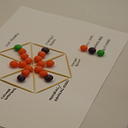Shaping Design and Designers: Intro
An intro to the diversity of design diversity
I’ve decided to set myself a challenge through December.
I will be sharing my latest thinking and work around ‘Shaping Designers and Design teams’. Through a series of posts, here on Medium.
Some of you may be familiar with my work already, especially the rather popular article I wrote over a year ago.
You can get a preview of what I will be writing about in my latest presentation. You can get it from the 2018 DesignOps summit’s site and Rosenfeld Media’s slideshare.
Slides here, and video shortly.
NB, it starts off with a vulnerable personal story which may not translate well on slides.
Touching a nerve
In a muddy world of digital/service/product/ux/ui design this work seems to resonate with many in the industry.
Ever since I shared early versions of my work in 2005 I’ve had a continual stream of comments from people using some of the frameworks.
I’ve followed up with chats on twitter, over video conferencing and even met people from all over the world in real life.
My posts and presentations over the past year have had several thousands of views. I must be onto something. It seems to be resonating.
We need diverse lenses for designer diversity
I’ve discovered many dimensions that help define differences between designers.
Dimensions of race, colour, geography, sex, or gender dominate industry discourse for diversity. I believe these are important dimensions. They may define a designer’s identity, how they might behave and how others perceive them.
My work has avoided these dimensions. In my research they rarely surface as dimensions that have an effect on performance. That doesn’t mean they don’t. In fact that learning itself may support the need not to exclude people that differ.
For various personal reasons I may go into in a future post I am ill equipped to cover this ground right now. My recent LinkedIn post and the resultant comments demonstrates this.
So, my work currently excludes some of those popular diversity dimensions.
Instead I focus on a variety of different dimensions. Things like:
- Design practice and knowledge
- Human/interpersonal/soft skills — whatever the right term should be
- Qualities and traits
- Foundational skills like writing and sketching
- Leadership responsibilities.
- Mindsets. Philosophies and more.
I’ll unpack these over my future posts.
Imperfect frameworks have been critical to learning
My Information Architecture skills are one of my weakest areas so bear with me.
My models and frameworks are imperfect. This has been important to the success of my work.
In our world of confusion we have a hunger for clarity of definitions. It’s only natural for articulate advocates to give clear and confident direction. It can help move the community forwards.
The work of Dan Saffer, Jesse James Garrett, Jared Spool, Todd Zaki Warfel and others have inspired me and my work. You should check it all out.
But I’m a Brit and a little more self-deprecating. Imperfection and humility are two of my tools for progress.
They help me create more frameworks. To move the conversation on from how exactly I define a category. And they get me past the fools errand of trying to be exhaustive.
Just to be clear, I don’t just pull them out of nowhere. Some have been researched over the last 13 years. Some have been developed from some considered thought. Reflecting on 20 years of commercial design practice. Working with hundreds of designers. And seeing the work of 1000s of designers up close.
How the frameworks help
Designers from around the world have used the frameworks for different purposes. To self-reflect. To direct their development. To understand their design team. To hire to a team’s needs. And most interestingly, to encourage a self-development culture within an organisation. I think there may be many other use cases.
If you’ve ever used any of my frameworks, please let me know how you got on. Let me know here, and on twitter.
Why do this?
I run my own consultancy business, Resonant, but this work rarely fits into my core offerings. Maybe I’ll do more in the future.
I have run conference and corporate workshops. But any compensation for those hasn’t covered the costs of my efforts. I just try to lose less money. But why bother?
Because I care.
Through my own self reflection, I’ve realised how important advancing the community is to me. It offers me positivity and purpose when I get feedback from others who find it useful.
And I have the opportunity to meet more and more designers of all shapes, styles and character from all over the world. Over video chat, on twitter, in a workshop, over a coffee.
Through the work, I get to see them deeper than I’d normally be able to. You only learn so much in a normal conversation. Especially if I met them at a conference or in a job interviews. And seeing the deeper sides of others helps me learn more about myself.
It’s not altruistic. I get personal value from it. Just not financial value.
But, to quote one of my favourite drum and bass anthems from PFM, For All Of Us
‘It’s for you, it’s for all of us’
I look forward to hearing your feedback and your stories of how you use this work.
Catch you in another post.
The full list of articles in the series
Now the series is complete, you can read all the articles listed below.
- Shaping Design and Designers: Intro
An intro to the diversity of design diversity - Map your career timeline
Mapping your emotional timeline over your career is a great way to start. - Blob mapping
Map your practice competency in a few minutes - UX Spectrum
A neat little interactive visual framework for profiling designers against key UX practice areas - False dichotomy mapping
The weirdest but most intriguing of profiling tools - Tools and techniques mapping
Understanding how you spend your work time - Soft shaping and the Perfect Experience Architect
Map the qualities, competencies and attributes that really matter to your work - No new post, but take this one on Boiling the Ocean of expected UX / Design capabilities
Damn I forgot one, but I think I posted something else on Linkedin and twitter on 8th December — will try and dig out - The dilemma of designers’ empathy delusions
Taking a bit of a reality check on how empathic you really are and for whom can help make you a more effective designer, not just an idealistic one. - Values prioritisation
A simple method of understanding your design team’s stance within an organisation - Diamond valuations
Using the Double Diamond to map and focus your team’s and your own design value - Directing design by stakeholder value
Understanding who you focus design value on - Classifying design value
Using frameworks to better clarify design’s value in your organisation - Design leadership mapping
Understanding where you are investing your leadership energy and where your team should - Framing DesignOps or Design Leadership focus
Reflecting on where you focus your efforts as a design operator or leader - Disciplines of DesignOps
Mapping the different disciplines fo design operators - Foundational skills
Remember to exercise the core muscles that drive design progression - Make your own leaving card
A powerful backcasting technique for directing your future - Skittle mapping
A fun and useful exercise for mapping yourself and focusing your future in your own way - Team development cards
A great way to capture development needs and mentoring potential within a design team - Five ways of wellbeing
How to make yourself and your team feel better through self-reflection, connection, learning and giving. - Primary vs secondary practices
Coping with the ever increasing set of competencies within User Experience and Digital Design - Competency model
Everyone seems to want a ladder, maybe they need a net

